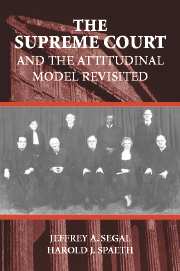Book contents
- Frontmatter
- Contents
- List of Illustrations
- List of Tables
- Preface
- 1 Introduction: Supreme Court Policy Making
- 2 Models of Decision Making: The Legal Model
- 3 Models of Decision Making: The Attitudinal and Rational Choice Models
- 4 A Political History of the Supreme Court
- 5 Staffing the Court
- 6 Getting into Court
- 7 The Decision on the Merits: The Legal Model
- 8 The Decision on the Merits: The Attitudinal and Rational Choice Models
- 9 Opinion Assignment and Opinion Coalitions
- 10 The Supreme Court and Constitutional Democracy
- 11 Conclusion
- Case Index
- General Index
10 - The Supreme Court and Constitutional Democracy
Published online by Cambridge University Press: 05 June 2012
- Frontmatter
- Contents
- List of Illustrations
- List of Tables
- Preface
- 1 Introduction: Supreme Court Policy Making
- 2 Models of Decision Making: The Legal Model
- 3 Models of Decision Making: The Attitudinal and Rational Choice Models
- 4 A Political History of the Supreme Court
- 5 Staffing the Court
- 6 Getting into Court
- 7 The Decision on the Merits: The Legal Model
- 8 The Decision on the Merits: The Attitudinal and Rational Choice Models
- 9 Opinion Assignment and Opinion Coalitions
- 10 The Supreme Court and Constitutional Democracy
- 11 Conclusion
- Case Index
- General Index
Summary
Not only do the justices serve lifetime appointments, as we pointed out in Chapter 1, they also bear primary responsibility for safeguarding the nation's fundamental law: the Constitution. Therefore, expectations that the Supreme Court should be responsive to the vagaries of public opinion bespeak either woeful ignorance or arrogant disregard of the character of the American judicial system. On the other hand, no one credibly alleges that the Court should lightly upset the actions of the other branches of the federal government or those of the state and local governments. Rather, the Court should lard its policy making with restraint.
The wisdom of such a course rests on several postulates. Judges, especially those holding lifetime appointments, are insulated and remote from the public's wishes and sentiments. Hence, they should – when the Constitution does not clearly mandate the contrary – defer to publicly accountable decision makers. Deference should also be accorded to state and local governmental officials because of the federal character of the constitutional system. Not all political wisdom (oxymoronic though the phrase be) emanates from Washington, and the bit that does may occasionally originate elsewhere than from the justices' marble palace. Furthermore, many issues, especially those of an economic, environmental, and technological sort, are highly and increasingly complex. Such matters require expertise for optimal resolution. Judges, consequently, should defer to the experts and not impose their amateurish judgments on the professionally competent.
- Type
- Chapter
- Information
- The Supreme Court and the Attitudinal Model Revisited , pp. 406 - 429Publisher: Cambridge University PressPrint publication year: 2002
- 1
- Cited by



